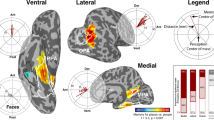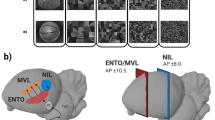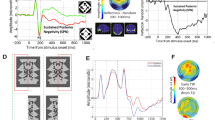Abstract
We report a patient with unilateral damage to the rostral part of the pulvinar who was impaired in localizing stimuli in the inferior visual field contralateral to the lesion and who made errors in the binding of shape and color in that quadrant. The findings demonstrate the importance of the pulvinar in spatial coding and provide support for the function of the thalamus in binding of features1. They also provide evidence for a homology between the visual field maps of the inferior and lateral subdivisions of the pulvinar in monkeys and in humans, such that the inferior visual field is represented in the rostral part of the nucleus.
This is a preview of subscription content, access via your institution
Access options
Subscribe to this journal
Receive 12 print issues and online access
$209.00 per year
only $17.42 per issue
Buy this article
- Purchase on Springer Link
- Instant access to full article PDF
Prices may be subject to local taxes which are calculated during checkout


Similar content being viewed by others
References
Crick, F. Proc. Natl. Acad. Sci. USA 81, 4586–4590 (1984).
Treisman, A. Curr. Opin. Neurobiol. 6, 171–178 (1996).
Treisman, A. & Schmidt, H. Cogn. Psychol. 14, 107–141 (1982).
Cohen, A. & Ivry, R. J. Exp. Psychol. Hum. Percept. Perform. 15, 650–663 (1989).
Prinzmetal, W., Henderson, D. & Ivry, R. J. Exp. Psychol. Hum. Percept. Perform. 21, 1362–1375 (1995).
Bender, D. B. J. Neurophysiol. 46, 672–693 (1981).
Petersen, S. E., Robinson, D. L. & Keys, W. J. Neurophysiol. 54, 867–886 (1985).
Robinson, D. L. & McClurkin, J. W. in The Neurobiology of Saccadic Eye Movements (eds. Wurtz, R. H. & Goldberg, M. E.) 337–360 (Elsevier, New York, 1989).
Cohen, A. & Rafal, R. D. Psychol. Sci. 2, 106–110 (1991).
Friedman-Hill, S. R., Robertson, L. C. & Treisman, A. Science 269, 853–855 (1995).
Talairach, J. & Tournoux, P. Co-Planar Stereotaxic Atlas of the Human Brain (Thieme, New York, 1988).
Acknowledgements
This work was supported by a grant from the Medical Research Council (UK). The research was approved by the Ethics Comittees of the University of Wales, Bangor, the North West Wales NHS Trust and the Conwy–Denbighshire NHS Trust. We thank T.N. for her help in these studies.
Author information
Authors and Affiliations
Corresponding author
Rights and permissions
About this article
Cite this article
Ward, R., Danziger, S., Owen, V. et al. Deficits in spatial coding and feature binding following damage to spatiotopic maps in the human pulvinar. Nat Neurosci 5, 99–100 (2002). https://doi.org/10.1038/nn794
Received:
Accepted:
Published:
Issue Date:
DOI: https://doi.org/10.1038/nn794
This article is cited by
-
The pulvinar nucleus and antidepressant treatment: dynamic modeling of antidepressant response and remission with ultra-high field functional MRI
Molecular Psychiatry (2019)
-
Gating and control of primary visual cortex by pulvinar
Nature Neuroscience (2012)
-
Emotion processing and the amygdala: from a 'low road' to 'many roads' of evaluating biological significance
Nature Reviews Neuroscience (2010)
-
Binding, spatial attention and perceptual awareness
Nature Reviews Neuroscience (2003)



